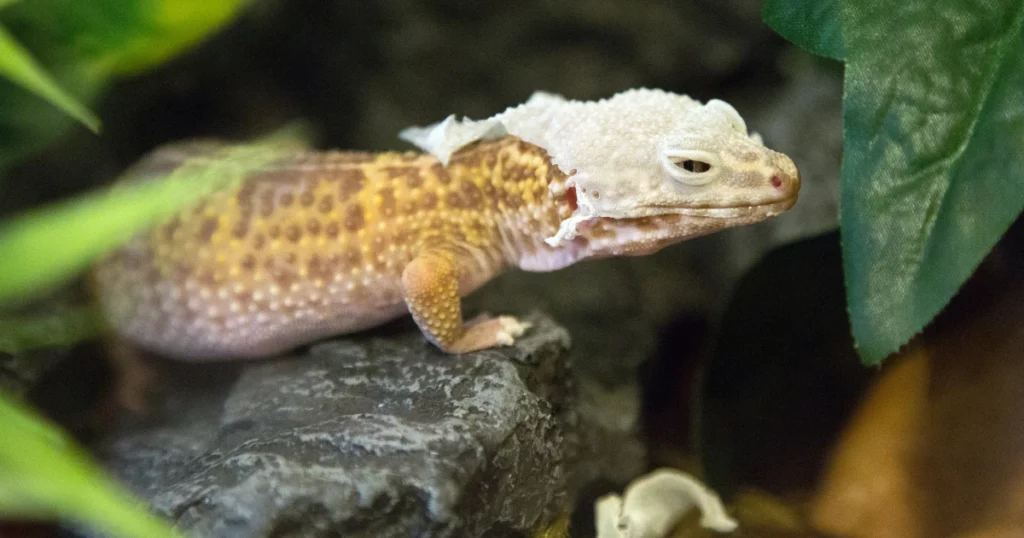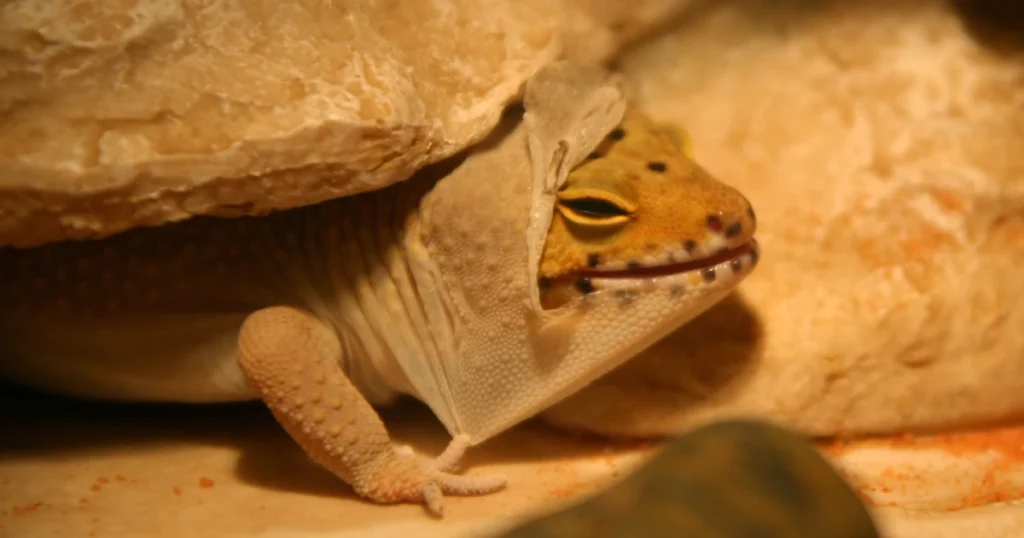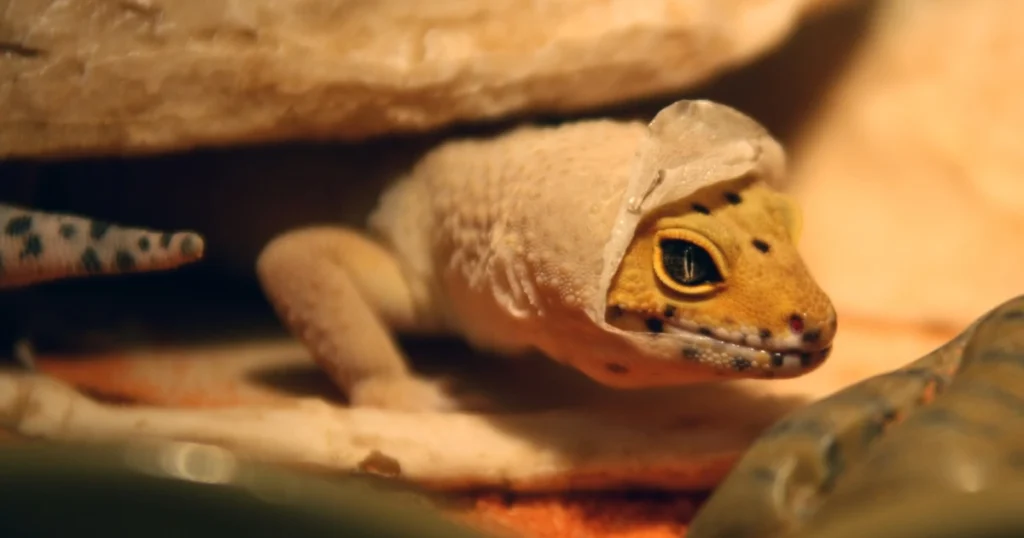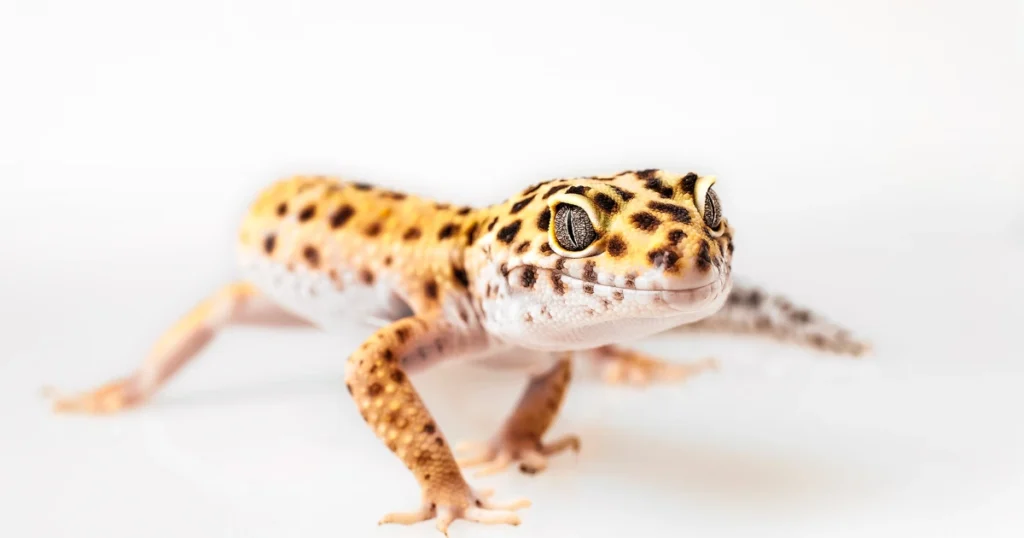
Ah, the joys (and trials) of being a leopard gecko parent! If you’ve ever found yourself staring at your beloved reptilian friend, still encased in that dreaded stuck shed, you’re not alone. As Ziggy’s human companion, Chirag, I’ve had more than a few shed-shedding scares with my feisty little guy, and I understand the concern and confusion that can arise when molting goes awry.
In this guide, I’ll share my personal experiences with Ziggy, along with tried-and-true tips, to help you navigate the often-tricky process of assisting your stuck shed leopard gecko. We’ll dive into the common questions, concerns, and misconceptions surrounding this issue, and I’ll provide practical solutions that have worked wonders for Ziggy and many other gecko guardians.
Understanding the Shedding Process
Before we dive into the nitty-gritty of dealing with a stuck shed, it’s essential to understand the shedding process itself. Shedding, or ecdysis, is a natural and recurring event for leopard geckos (and most reptiles) as they grow and replace their old skin with a fresh, new layer.
During this process, your gecko’s body will begin to separate from the old skin, creating a gap between the two layers. As the shedding progresses, the old skin will eventually peel off in one piece, revealing a brand-new, vibrant skin underneath.
While shedding is a normal and necessary part of a leopard gecko’s life cycle, it’s not uncommon for problems to arise. Factors like improper humidity levels, inadequate shedding aids, or even stress can lead to a stuck shed, where the old skin fails to come off completely, leaving your gecko looking a bit like a scaly mummy.
Common Questions and Concerns
As a fellow leopard gecko parent, I know firsthand the concerns and questions that can arise when dealing with a stuck shed. Here are some of the most common ones I’ve encountered (and experienced myself with Ziggy):
Q: Is a stuck shed dangerous for my leopard gecko?
A stuck shed can be potentially harmful if left unaddressed. The retained skin can constrict your gecko’s movement, impair their vision, and even lead to infections or circulation issues if left for too long. It’s essential to address the issue promptly to ensure your pet’s well-being.
Q: How can I tell if my leopard gecko has a stuck shed?
Telltale signs of a stuck shed include: Pieces of old skin remaining on the gecko’s body, especially around the toes, eyes, or tail Dull or discolored skin patches that haven’t shed properly Difficulty opening the eyes or mouth fully
Q: Can I remove the stuck shed myself?
While it’s tempting to try and peel off the stuck shed yourself, I strongly advise against it. Improper removal can lead to injury, stress, and even more severe shedding issues. It’s best to seek professional assistance or follow a safe, gentle approach under proper guidance.

Ziggy’s Shedding Saga
Let me share a personal story to illustrate the importance of addressing stuck sheds promptly and properly. A few months ago, Ziggy was going through his regular shedding cycle, but something wasn’t quite right. Despite my best efforts to maintain the optimal humidity levels and provide shedding aids, he ended up with a stubborn piece of shed stuck around his eye.
At first, I tried to gently moisten and remove it myself, but Ziggy was having none of it. He squirmed and protested, and I quickly realized that forcing the issue would only cause more stress and potential harm. It was time to seek professional help.
I reached out to my trusted reptile veterinarian, who advised me on a safe and gentle approach. With their guidance, I set up a warm, humid shedding box and allowed Ziggy to soak and shed at his own pace. After a few days of patience and monitoring, the stuck shed finally came off on its own, revealing a bright-eyed, healthy Ziggy underneath.
This experience taught me a valuable lesson: sometimes, the best approach is to let nature take its course, while providing the right environment and support for your gecko to shed comfortably.
Step-by-Step Guide to Assisting a Stuck Shed Leopard Gecko
Now that we’ve covered the basics and addressed some common concerns, let’s dive into a practical step-by-step guide to help your stuck shed leopard gecko. Remember, every gecko is unique, so it’s essential to monitor your pet’s progress and adjust the approach as needed.
Step 1: Create a Shedding-Friendly Environment
The first step in assisting a stuck shed is to ensure your gecko’s enclosure has the right conditions to facilitate a successful shed.
- Humidity: Leopard geckos shed best in higher humidity levels, around 40-60%. You can achieve this by misting the enclosure regularly or using a humid hide (a small, enclosed space with damp sphagnum moss or paper towels).
- Shedding Aids: Provide rough surfaces like rocks, bark, or shedding aids (commercially available products designed to help geckos shed) to allow your gecko to rub against and help remove the old skin.
- Warmth: Maintain a warm basking spot around 90-95°F (32-35°C) to encourage shedding.

Step 2: Soak and Hydrate
If your gecko is struggling with a stuck shed, a warm water soak can be a game-changer. Here’s how to do it:
- Prepare a shallow container with lukewarm water (around 85-90°F or 29-32°C).
- Gently place your gecko in the water, ensuring their head remains above the surface.
- Allow them to soak for 15-20 minutes, keeping a close eye to prevent any potential drowning hazards.
- The warm water will help rehydrate and loosen the stuck shed, making it easier for your gecko to remove it.
Step 3: Create a Shedding Box
If the soak alone doesn’t do the trick, it’s time to set up a dedicated shedding box. This controlled environment can provide the ideal conditions for your gecko to shed comfortably and safely.
- Use a small, well-ventilated container or plastic bin.
- Line the bottom with damp paper towels or sphagnum moss to maintain high humidity.
- Add a rough surface (like a piece of bark or a shedding aid) for your gecko to rub against.
- Provide a shallow water dish for hydration.
- Place the shedding box in a warm, quiet area away from any potential disturbances.
Step 4: Monitor and Be Patient
Once your gecko is in the shedding box, the key is to let nature take its course. Resist the urge to intervene or remove the shed manually, as this can cause more harm than good.
- Check on your gecko regularly, but try not to disturb them too much.
- Maintain the humidity levels by misting or changing the damp substrate as needed.
- Be patient! It may take a few days (or even a week) for the stuck shed to come off completely.
If you notice any signs of distress, infection, or the shed isn’t progressing after a week, it’s best to consult a reptile veterinarian for further assistance.
Additional Tips and Tricks
Here are a few extra tips and tricks I’ve learned along the way to help make the stuck shed process smoother for both you and your gecko:
- Supplements: Ensuring your gecko has a well-balanced diet with calcium and vitamin D3 supplements can promote healthy shedding.
- Shed Monitoring: Familiarize yourself with your gecko’s regular shedding schedule and look for signs of an upcoming shed (like milky eyes or dull skin) to stay ahead of the game.
- Handling: Avoid handling your gecko during the shedding process, as this can cause unnecessary stress and potentially disrupt the shed.
- Hydration: Provide fresh, clean water at all times, as proper hydration is crucial for a successful shed.
- Patience: Above all, be patient and let your gecko shed at their own pace. Forcing the process can lead to injury or further complications.

A Bonding Experience
While dealing with a stuck shed can be frustrating and concerning, I’ve found that it can also be a unique bonding experience with your leopard gecko. By providing the right care and support during this vulnerable time, you’ll not only ensure their well-being but also strengthen the trust and connection between you and your scaly friend.
Remember, every gecko is unique, and what works for one may not work for another. Don’t be afraid to seek professional guidance or adjust your approach as needed. With patience, dedication, and a little bit of gecko love, you’ll navigate this shedding challenge like a pro.
So, fellow leopard gecko parents, embrace the stuck shed saga as an opportunity to deepen your understanding of these fascinating creatures and cherish the moments of growth and resilience they offer us.
Stay Engaged, Stay Informed
I hope this guide has provided you with valuable insights and practical tips for assisting your stuck shed leopard gecko. But the learning doesn’t have to stop here! Stay engaged with the reptile community by:
- Joining online forums and Facebook groups dedicated to leopard geckos and reptile care
- Following reputable reptile breeders, enthusiasts, and experts on social media
- Attending local reptile expos or events to network and learn from experienced keepers
By staying informed and connected, you’ll not only stay up-to-date on the latest care techniques but also have a support system to turn to when you have questions or concerns.
And don’t forget to share your own experiences and tips with others! Your unique perspective and personal stories can be invaluable resources for fellow leopard gecko lovers navigating the joys and challenges of reptile parenting.
Closing Thoughts
Dealing with a stuck shed leopard gecko can be a daunting experience, but with the right knowledge, patience, and care, it’s a challenge that can be overcome. Remember, your gecko’s well-being should always be the top priority, and seeking professional assistance when needed is never a sign of failure – it’s a sign of a responsible and caring reptile parent.
So, embrace the stuck shed saga as an opportunity to deepen your bond with your scaly friend, and don’t hesitate to reach out to the vibrant reptile community for support and guidance. Together, we can ensure our leopard geckos shed in comfort and style, one successful molt at a time. Happy shedding, my fellow gecko guardians!
